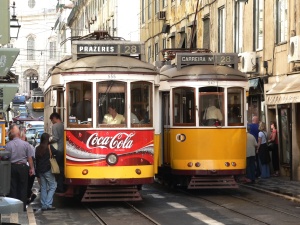As I love going to Lisbon, I am going to explain this portuguese city, some of the monuments that people can see there and portuguese food.Lisbon is the capital of Portugal and it is considered to be one of the oldest cities in the world. In Lisbon the climate is mediterranean.The weather is hot in summer. As Voltaire said, after the earthquake, which had destroyed three-quarters of Lisbon, the country’s wise men had found no more efficacious means of preventing total ruin than to give the people a fine auto-da-fé.
Places to explore:
Alfama
Alfama is constituted streets and alleys that are very steep and its levels are connected by flights made with stone steps.
Belém
In this district grandest monuments and museums are located. From Belém explores set out during the period of the discoveries. The monuments that people can see are:
The Tour of Belem which comes from the country’s purest Manueline structure. The Belem tour was built between 1514 and 1520 on what was an island, in order to defend the port entrance. This monument is dedicated to St.Vicent,the patron of Lisbon. People can cross the wood gangway and walk inside. The is not so much to see the plain interior but rather to climb the steps for a bird’s-eye view of river and city.
“Mosteiro dos Jeronimos” which is an unesco world heritage site, is a supreme example of the Manueline style of building (named after Dom Manuel I). This monument represent a marked departure from Earlier Gothic architecture. Inside the monument, the spacious interior contrast with the riot of decoration on the six nave columns and complex latticework ceiling.
Chiado and Bairro Alto
West of the Baixa is the fashionable shopping district of Chiado. A decade after the calamitous 1988 fire destroyed much of the area, an ambitious rebuilding program restored some fin de siècle facades.
Uphill, the Bairro Alto dates back to the 17th century, but most of its buildings are from the 18th and 19th: an appealing mixture of old grocery stores, art galleries, and town houses with wrought-iron balconies
The Modern City
The Avenida da Liberdade, which was laid out in 1879, make Lisbon’s downtown axis a pleasant place to linger, despite the traffic. In the Modern City people can explore the “Oceanario de Lisboa”.
It is considered the Europe’s largest indoor aquarium wows children and adults alike with a vast salt-water tank featuring an array of fish, including several types of shark. In this Oceanario people can find the way you pass through habitats representing the North Atlantic, Pacific, and Indian oceans, where puffins and penguins dive into the water, sea otters roll and play, and tropical birds flit past you.
Portuguese cuisine:
- Baked salted cod with cream (bacalhau com batas)
- Braised salt cod (bacalhau a bras)
- Cream cake (tarta de natas)
- Belem cakes ( pasteis de belem, pasteis de natas)
References:
Lisbon travel guide. (Retrieved December 20,2013). (In fodors travel). Retrieved 18:00 December, 12,2013 from http://www.fodors.com/world/europe/portugal/lisbon/
Discover Lisbon. Turismo de Portugal, Lisboa. (Retrieved January 16,2014). (In visit lisboa). Retrieved 17:00 January, 16,2014 from http://www.visitlisboa.com/AboutUs.aspx
Leire Sáenz-Cortabarría Morales
